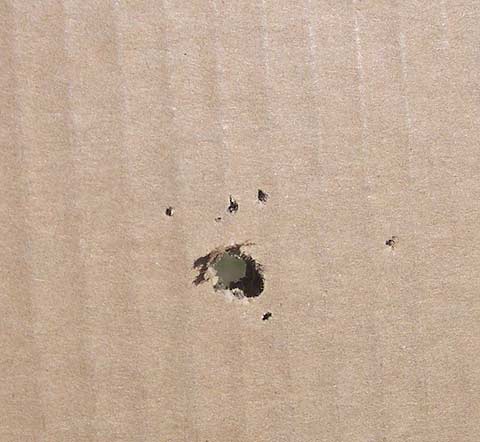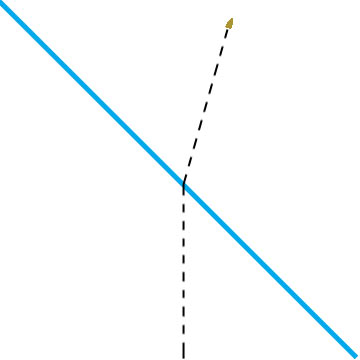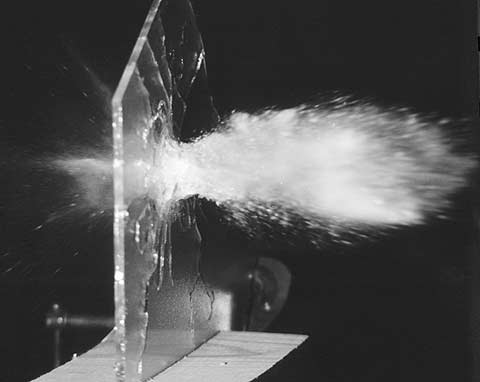What Happens
Conerns
Conclusion
Introduction
When considering shooting through barriers, glass is probably the number one barrier to consider for obvious reasons, it is about the only barrier a shooter can see through. Barrier shooting, or more specifically glass shooting, is a very tricky subject to discuss because there are so many variables involved, and so many millions of different things that can effect the bullet in different ways when it passes through glass that this discussion becomes far from factual or even theoretical and more just general observational. It would be great if things happened the same every time, or that all types of glass behaved the same, but it does not, and as such, it makes this article a good bit harder to provide any definitively useful information! With that introduction being said and the preface being laid for what we hope to cover in this article, let us at least attempt to provide some sort of useful insight into glass barrier shooting.
Law enforcement sniping will run into glass barrier shooting more frequently than Military snipers, but with the increase in limited rules of engagement conflicts in the past few decades, the military sniper is being faced with the same challenge more frequently than ever and this article may be of use to the military sniper as well.
What Happens?
Perhaps the title of this section should be "what usually happens". As a bullet travels through the atmosphere there are constant pressures and weather effects that act upon the bullet, but in that case, the effects are actually relatively small or non traumatic. But when that bullet passes through a glass barrier, there are very traumatic forces that now act upon the bullet. To complicate matters, there are many different types of glass with different thicknesses, hardnessís, and additional different materials within the glass itself, not to mention there are many different types of bullets and bullet construction. When the bullet passes through the glass, there are tremendous forces acting on the glass from the bullet and in return acting on the bullet from the glass. These forces acting upon the bullet from the glass in such a violent collision usually cause three major things to happen: bullet deformation, bullet deflection or deviation from flight path, and shards & debris. Each of these three things is critical to "try" and understand so they can be taken into consideration when contemplating taking a shot.
In the next section we will discuss each of the three concerns separately to provide some idea of what to expect. Many people do not realize the drastic effect glass can have on a bullet, for some reason the average person tends to think that a bullet is fast and deadly and a simple thing like glass will not profoundly affect the bullet or its flight, but that is very far from the truth. The extreme energy a bullet carries with it is actually one of the main things that causes such problems.
Concerns
We will now individually address each of the three major concerns with glass barrier shooting:
- Bullet Deformation: When a bullet passes through a glass barrier, there are several
things that physically happen to the bullet to deform its shape from the original shape of the
bullet. Probably the most common deformation on a match grade type of bullet with the hollow
tip is that the jacket itself may be stripped and separated from the lead core of the bullet.
Because of the manufacturing procedures of match grade bullets with the hollow tips, there is
a hollow void at the top of the bullet that you cannot see, this void, combined with a thin and
weak jacket found on match bullets, many times causes jacket separation or fragmentation to
occur when a bullet passes through a glass barrier.

The above picture shows a piece of cardboard that was struck by a 308 168gr Sierra Match King bullet after it passed through a piece of tempered 1/8" glass 9 feet in front of it and placed at a 90 degree angle, and then another piece of cardboard 1' in front of this piece. As you can see, the hole is odd shaped showing either deformation or a unstable bullet (most likely both) and even more telling is the fragmentation that has happened. Each of those smaller holes is more than likely a piece of bullet jacket.
Probably the biggest single concern about fragmentation is terminal bullet performance. Without the jacket fully intact and a non-stabilized lead core as the main projectile, penetration will be jeopardized and may potentially not provide the instant incapacitation necessary. According to the FBI glass barrier study on 308 ammo conducted in 1992, the performance of the HPBT sierra bullets through glass was identified as having serious short comings. The test has a large compilation of data on bullets shot into ballistic gelatin placed at 3, 8, and 10 feet behind many different types of glass. On 1" insulated glass (two sheets of glass with air in between for insulation) that is commonly found on commercial buildings and in new constructed homes, with the gelatin 10 feet behind the glass, a 168gr HPBT penetrated only 5" and retained 50grs of weight. This was fired at 100 yards with the glass 90 degrees to the target/shooter. There was major fragmentation on the entire 14" face of the gelatin. At 8' behind the glass, the penetration was about 10" and fragmentation was spread over 10" and weight retention was just as bad on the projectile. This is common glass now and with performance like that, lethality would certainly be in question. The bullet does perform better with less extreme glass like 1/8" tempered safety glass as is found on the side windows of cars or doors of commercial buildings, but fragmentation continues to be common.
On automobile windshields, 1/4" laminated glass is typically used, and with the target only 3 feet from the glass, the 168gr penetrated only about 11" and retained around 40 grains of weight (on average). There was major bullet fragmentation over an 8" circle. These are just a few of the examples of very poor bullet performance through glass with the 168gr HPBT bullet, but, that should probably be expected as the bullet was not designed for deep penetration but for extreme accuracy. Let us not forget it was first designed as a target bullet, not a sniping bullet.
So what do we do? Probably the single biggest problem is the actual bullet construction of the Sierra Match King bullet, and the easiest way to improve that is to use a different bullet. The FBI determined that the best performing bullet AT THAT TIME was the Trophy Bonded Bear Claw bullet built by Speer Bullets. This bullet has a fusion bonded core, solid copper shank and a thicker wall to help keep the bullet intact when passing through tissue, and glass barriers in this case.

Cross section of Trophy Bonded Bear Claw bullet.
In the same insulated glass test that I mentioned above, the TBBC bullet retained 140 grns (of its original 165), penetrated 19.5" of gelatin and there were no fragments on the gelatin face. In the same car window test the bullet retained 150+ grains, penetrated 20+ inches and there was no fragmentation. So, as is apparent in these tests, the bullet construction makes a huge difference in the performance of the bullet as it travels through a glass barrier. There have actually been many new bullet designs that have come out since the time of these FBI tests and I suspect that they would perform just as well or perhaps even better. The fusion bullet designs should do quite well and even the Barnes solid copper bullets with no jacket would be another one to possibly test.
There are, of course, limitations to using these types of bullets, of which the most important is probably the lack of match grade ammunition loaded with them, and the lack of extreme accuracy that the bullets themselves will demonstrate. There is some law enforcement only "glass busting" ammunition loaded out there and your department may be wise to start investigating some of these manufacturers. Of course, handloads could work, but most departments do not allow handloads for the extra liability it would entail. The last option is to use premium hunting ammunition loaded with these bullets. Many of the premium loadings are very accurate and could be used to work very well. Of course, ANY of these options will require testing and good notes in your log book because the zero for this ammo vs. your typical match ammo WILL be different! Of course, do not base a duty load off of my report here or the FBI findings, PERFORM YOUR OWN TESTS.
There is one last problem with the Trophy Bonded bullets and it is specifically for the military shooters, it is a soft point and designed to expand, which is forbidden in the laws of land warfare, and not able to be used. So, what are your options? There are not a whole bunch, BUT, if you can find some original M118 ammo with the 173 gr FMJBT bullet (not the M118LR), it is an excellent glass busting round due to its thick jacket and no hollow tip. If none of that is available (they stopped making it a while ago), then the 147gr FMJBT ammo used for the machine guns "may" work better, though I have seen no reports on it and I am only basing it off the fact that the bullets are usually fairly robust, but the big problem is going to be the accuracy of the machine gun ammo, it is usually not very good.
The one last thing I wanted to mention about the bullet performance and deformation is the possible use of the simu-shot, or the taking of the shot at the same, or near same, time by two separate snipers. The idea is that the first shot will break the glass giving the second shot a clean passage. Of course, it takes extreme coordination with active communication between the two snipers and two clear shots. The first shot should be aimed as a kill shot also. Other concerns include the fact that the 2nd shot may still hit glass shards, the shots have to happen at the same time in order to keep the target from moving, and most importantly, YOU HAVE TO KNOW WHAT TYPE OF GLASS IT IS! If it is laminated, the glass is not going to shatter. This is a tricky maneuver and should be executed after practice and with extreme caution.
- Bullet Deflection/Deviation:
As the bullet passes through the glass barrier, some of those extreme forces acting on the
bullet can alter its course causing the bullet to impact in a spot other than the point of
aim. This deflection is magnified the steeper the angle at which the bullet strikes the glass.
I have seen many books claim that the bullet will actually deflect "toward" the angle at
which it strikes the glass, as seen in the diagram below:

But in my limited testing and in reviewing the results in the FBI tests, I see no real indication that you can count on the bullet deflecting in that specific direction (into the angle). Now, shooting at an angle certainly causes deflection in most cases but it tends to be more random than anything. Again, let me state that this is just the results of some very limited testing I have done through tempered glass and from reading the FBI tests from 1992. There could very well be more proof showing that this is indeed the case, and most sniping manuals preach it, but it is just not what I have seen. The shot below was fired through a piece of 1/8" tempered glass that was sitting at a 45 degree angle to the shooter, the glass was upright (vertical) with the left side angled 45 degrees back, which should have caused the bullet to strike to the right of the point of aim.

The rifle was zeroed for point of aim and you can see the bullet struck a little over an inch high. The target was 8 feet behind the glass and of particular note, look at the shape of the bullet hole, it is clear that the bullet was either severely deformed or tumbling/spinning wildly when it hit the target. This was a 168gr HPBT Sierra, and as I discussed in the section about deformation, this bullet takes a beating when passing through glass. I personally feel that the bullet gets so beat up passing through the glass that trying to predict the point of impact is going to be near impossible, especially the further away from the glass that the target is. The FBI tests seemed to confirm this assumption due to a number of shots showing some randomness to point of impact when fired through 45 degree angled glass.
The one thing that is consistent through my limited tests and the FBI findings is that if fired at a 90 degree angle to the glass, there is generally no deflection. Of course, that is dependent on the distance of the target from the glass and just how much bullet deformation happens, but as a general rule, if possible, insure you are firing as close to 90 degrees to the glass as you can. Another thing is that with the good glass busting bullets, the deflection is minimized when shooting at an angle to the glass.
- Shards & Debris:
The final concern with glass shooting that I wish to cover is the shards and debris that is
projected as a bullet passes through glass. If it is a hostage situation and the hostage is
close to the target, and they are both close to the glass, there is a possibility of injury
to the hostage. There is concern of the glass debris as well as bullet debris and fragments
striking the hostage and causing considerable harm or possibly even death. While it appears
that a bullet travels fairly cleanly through glass, the picture below should help illustrate
that this is not the case.

While much of the glass debris is more of a dust and should cause minimal damage and does not travel very far, there are some larger fragments that can cause harm. The bullet fragments that can be created with fragile bullets like the Sierra Matchkings are also a potential problem. Now, we cannot do much about glass debris and shards, but by using good glass penetrating bullets, we can minimize bullet fragments.
The further away from the glass a target is, the less concern with glass debris, but there is a greater amount of deflection from bullet travel with damaged bullets and bullet fragments. As many of these types of situations as possible should be discussed with team members, leaders and other critical decision makers BEFORE the team is in a situation that the call needs to be made. Again, any first hand testing that can be done is also extremely desirable.
Well, I am not totally sure I provided any earth shattering information or revelations, but hopefully I did provide some useful information. Glass shooting is risky and there are a lot of variables involved with a successful shot. But sometimes risky shots need to be taken to save an innocent life. It is best to have as much experience and knowledge as possible to evaluate the risks and calculate the effects as much as possible, and nothing can replace first hand experience. Glass shooting tests can be very time consuming and expensive, but the knowledge gained more than makes up for it.